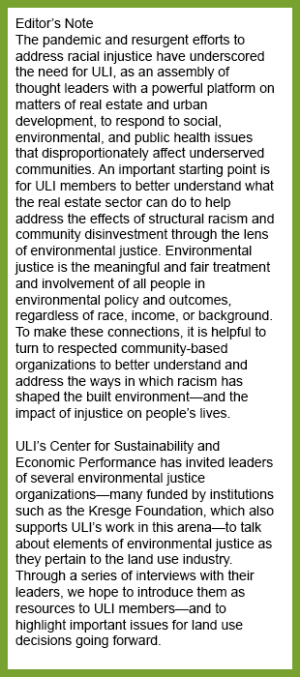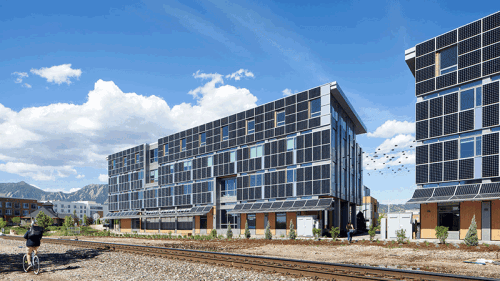Location: Boston, MassachusettsFind Out More: iejusa.orgType of Organization: Research and technical assistancePrimary Funding: Foundation-funded programInterview With: Shalanda H. Baker, professor of law, public policy, and urban affairs, Northeastern University; cofounder and codirector, Initiative for Energy Justice. Baker is the author of the forthcoming book Revolutionary Power: An Activist’s Guide to the Energy Transition (Island Press).
Mission: The Initiative for Energy Justice aims to: (1) contribute to a bottom-up movement of energy justice, originating in frontline communities, by arming movement and base-building organizations in the environmental, racial, and economic justice spaces with well-supported policy research and workable transactional models for operationalizing a just transition to renewable energy; and (2) provide city and state policymakers with concrete energy policy frameworks and best practice tools that foreground equity in the transition to renewable energy, drawing on the best available data collected from frontline advocates, existing energy policies, and frameworks designed by our team.
Description: The Initiative’s team is made up of codirectors Shalanda H. Baker and Subin DeVar, communications team lead Melissa Sonntag, and interdisciplinary student researchers ranging from the undergraduate level to the law student and PhD level. In our work on the ground, we noticed that structural inequality and racial equity were not a consistent part of the energy policymaking process. We formed the Initiative for Energy Justice in 2018 to address the need to infuse equity into society’s transition away from fossil fuels and to ensure that this transition does not replicate the inequality already baked into the energy system.
The shape of our energy system links directly to the built environment. One of our cofounders, Professor Baker, a professor of law, public policy, and urban affairs, sits on the Massachusetts Energy Facilities Siting Board, which makes decisions about whether an energy facility can and should be located in a certain community. Justice requires that certain communities not disproportionately bear the burden of energy facility siting. For example, historically, Black and Brown communities have borne the burdens of fossil-fuel generation. Our work addresses these concerns, too, since clean energy facilities can be concentrated in environmentally sensitive locations or in communities already burdened by environmental hazards.
How do you define environmental justice in your work?
We’ve written a guide, the Energy Justice Workbook, to discuss the links among energy justice, climate justice, and environmental justice. These concepts are tied together by decades of research and scholarship, as well as community advocacy. In our workbook, we rely on the careful work of environmental justice scholars and advocates in the field, and we define environmental justice as having two key components: procedural justice and substantive, or distributive, justice. Procedural justice requires that communities have a meaningful voice in environmental decision-making, whereas distributive justice requires the equitable distribution of the burdens and benefits of environmental decisions. Environmental justice, as we define it, requires the recognition and remediation of the disproportionately high and adverse human health or environmental effects on communities of color and low-income communities.
How would you describe your experiences working with the real estate sector? What do you hope to see in the future from the real estate sector, especially given increased awareness of racial and environmental justice concerns?
Real property and the rules associated with it form an important backdrop to the work of energy justice. For example, residents of many low-income homes experience extreme energy burdens (high energy costs) because their homes are inefficient or need upgrades to maximize energy efficiency. Low-income homeowners can sometimes access local or state programs to offset the cost of efficiency upgrades to create long-term savings. For renters, however, the situation is more complicated. There is a split incentive: landlords lack the incentive to pay for efficiency upgrades because they do not live in the home and their tenants, not they, would be the primary beneficiaries. The split incentive problem reappears in the context of rooftop solar investments that could drastically reduce a renter’s energy burden. We would love to see more innovation on the part of policymakers to mitigate the split incentive problem facing property owners.
How do you approach those who may be skeptical about the need for energy justice?
Unfortunately, skepticism is more common than not. Up until COVID-19, many policymakers and mainstream climate advocates had been slow to make the connection between broader racial inequality and economic injustice and the need for just energy policy. Many prominent climate change stakeholders have expressed concern that including equity in energy and climate policy conversations upfront will unnecessarily delay progress and possibly derail any chance to avert catastrophic climate change. Before COVID-19, we argued that our fates with respect to climate are inextricably linked and that we have an unprecedented opportunity to right the wrongs baked into the fossil fuel–based energy system. The pandemic has revealed the raft of issues facing communities of color in this country, but we still have a long way to go.
What uptake have you seen from policymakers in focusing on equity in new climate or energy policies, and how can the real estate sector help accelerate that process?
New York state’s Climate Leadership and Community Protection Act (CLCPA) is one of the most ambitious and promising pieces of legislation out there. The CLCPA was drafted in collaboration with frontline community groups (a form of procedural justice, referenced above) and includes a range of provisions concerning equity and ensuring that traditionally excluded communities benefit (a form of substantive, or distributive, justice) from New York state’s ambitious transition away from fossil fuels.
Real estate issues are implicated in the siting of energy facilities as well as the background rules that structure the incentives related to energy issues. In term of next steps, the real estate sector could play an active role in advancing racial justice by first ensuring that stakeholders “do no harm” and their developments do not increase environmental burdens in communities of color. For example, rather than facilitating the siting of dirty projects, the industry can help create pathways for local, small-scale energy projects, such as community solar, in communities that bear the burden of pollution, waste, and other environmental hazards. These tend to be low-income communities, communities of color, and rural communities. Advocates, policymakers, and scholars often refer to these as “environmental justice” communities. Second, on the energy side, real estate stakeholders can work to lobby policymakers to create policies that eliminate the split incentive problem for investments in energy efficiency upgrades. Finally, the industry can work with lawmakers and policymakers to create opportunities for clean energy investments in and by low-income communities.
To obtain a copy of the Energy Justice Workbook, visit https://iejusa.org/workbook/.
ULI Member Perspective: Exploring Issues of Environmental Justice and Land Use




